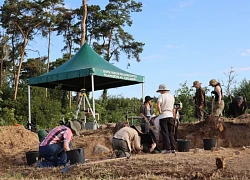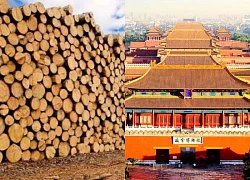The mystery of 'tree people': Plants know how to 'walk', take root 'legs', move on their own, causing TG fever
In the midst of the tropical rainforests of the Americas, there are mysterious legends about plants that can move like humans. They possess roots like 'legs' that move on their own to where they want to amaze TG.
The only "walking" tree in the world is scientifically named Socratea exorrhiza. The "walking tree", is a special species of palm tree that lives in tropical rainforests in Central and South American countries such as Ecuador. They have a long and strong root system, which grows out of the trunk and plunges straight into the ground, looking very much like tentacles.
The name "walking tree" is because they can move from the shade to sunlight by planting new roots in the direction they want to move, while the old roots will slowly pop up, dry out and rot.
Besides, this process can take several years, but some people say that the tree can "walk" 2 or 3 centimeters per day or 20 meters per year.
Speaking of the world's only "walking" tree, Peter Vrsansky, a paleontologist from the Institute of Earth Sciences of the Slovak Academy of Sciences, Bratislava, claims that he witnessed the phenomenon firsthand during a forest expedition in Ecuador.
This biologist explains that these trees grow new long roots in search of solid soil after soil erosion. In search of a solid foundation, these palm trees usually have to move 20m from their location.
The BBC quoted the scientist as saying: "Then, slowly, as the roots cling to the new ground and the tree patiently bends towards the new roots, the old roots slowly fly into the air."
According to Peter Vrsasky, the whole process of finding a new location with solid ground and better sunlight can take several years.
The root system of the Socratea exorrhiza plant is vigorous, and many roots sprout from the base of the plant a few feet above the ground.
It is worth mentioning that the plant has the ability to move from a dark location to sunlight by producing new roots in the direction of light, while old roots slowly lift up and die.
Socratea exorrhiza still plays an important role in rainforest ecosystems. Because, plants provide habitat and food for many animals. In particular, the leaves of the Socratea exorrhiza plant are food for sloths and monkeys, while the stems are a shelter for insects and invertebrates.
Not only that, but locals also use the leaves of the Socratea exorrhiza tree to weave into baskets, mats and roofs, and the wood of the tree is used in construction and as a source of fuel.
Although the Socratea exorrhiza plant is not really "walking", this particular thing still makes for wonder and is an important part of biodiversity in tropical forests.
A study by biologist Gerardo Avalos in 2005 showed that the tree, which is capable of growing more roots, actually does not move at all. They grow more roots that change their shape compared to before, but that doesn't mean they "walk."
Responding to the scientific journal Live Science (USA), Mr. Gerardo said: "My recent research confirms that the walking palm tree is just a myth. I think they can slightly change the direction of the canopy to catch the light thanks to the roots that grow to the side. The story of them being able to "move around" in the forest is just a legend that tour guides often tell to guests to add to the thrill."
According to legend, these trees can travel up to 20 meters per year. If that's true, all walking palm trees will travel at least 1km in just 50 years. And when that has happened, there will surely be someone who will notice. But so far, no one has confirmed this.
Is Negav's strange disease the cause of offensive and dangerous speech?  Snow20:54:05 02/10/2024In the past few days, Negav has been the hottest name on forums because of a series of non-standard statements and actions. However, few people know that the guy has had a disease since he was a child.
Snow20:54:05 02/10/2024In the past few days, Negav has been the hottest name on forums because of a series of non-standard statements and actions. However, few people know that the guy has had a disease since he was a child.

















 Revealing the secret in the ancient "pyramid" tomb in Poland, surprising archaeologists!
Revealing the secret in the ancient "pyramid" tomb in Poland, surprising archaeologists! Annabelle doll caused a man to die in a 'ghostly' way, because he knew this secret?
Annabelle doll caused a man to die in a 'ghostly' way, because he knew this secret? The most tragic beauty in Vietnamese history, from the Ly Dynasty king to the Tran Dynasty general's wife
The most tragic beauty in Vietnamese history, from the Ly Dynasty king to the Tran Dynasty general's wife Rare girl has 81 teeth, exceeding the normal limit, doctors "give up"?
Rare girl has 81 teeth, exceeding the normal limit, doctors "give up"? Is there a place in the Forbidden City so scary that no one wants to step through it a second time?
Is there a place in the Forbidden City so scary that no one wants to step through it a second time? Forbidden City, 600 years indestructible, even termites give up: Is there a "talisman" against destruction?
Forbidden City, 600 years indestructible, even termites give up: Is there a "talisman" against destruction? The Mystery of Wu Zetian's Tomb "500 Ton Treasure", No One Dare to Excavate for 1,300 Years!
The Mystery of Wu Zetian's Tomb "500 Ton Treasure", No One Dare to Excavate for 1,300 Years! The "naked" truth about China: 14 rare photos reveal a tragedy that goes beyond the movies
The "naked" truth about China: 14 rare photos reveal a tragedy that goes beyond the movies After 2 years of drinking weight loss tea, the man turned pale during a colonoscopy?
After 2 years of drinking weight loss tea, the man turned pale during a colonoscopy? The tragic love story of the Nguyen Dynasty Princess, who was infatuated with a Zen master and died in pain.
The tragic love story of the Nguyen Dynasty Princess, who was infatuated with a Zen master and died in pain. Princess Hoa Hieu Ai is favored by Qianlong and her life is full of changes!
Princess Hoa Hieu Ai is favored by Qianlong and her life is full of changes! There are only 2 individuals left in the world: Is this animal waiting for extinction?
There are only 2 individuals left in the world: Is this animal waiting for extinction?
3 | 0 Discuss | Report